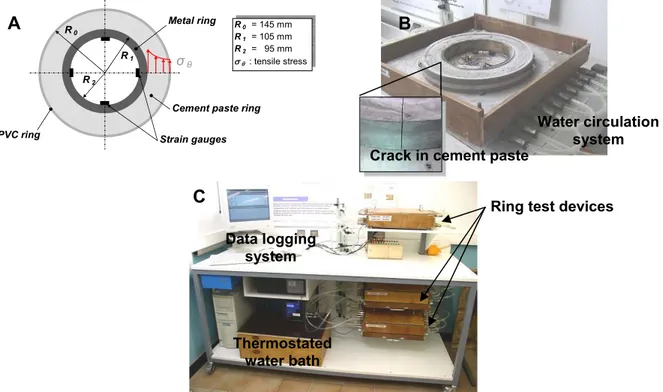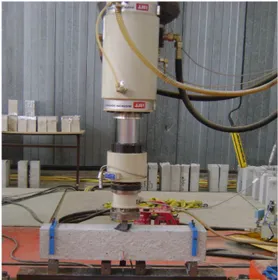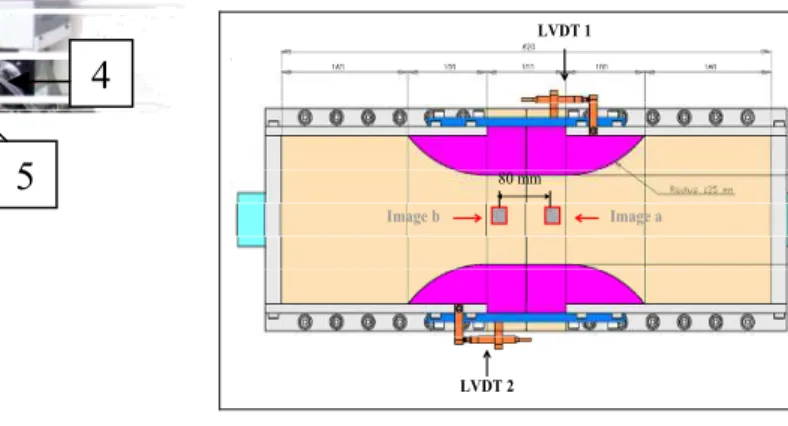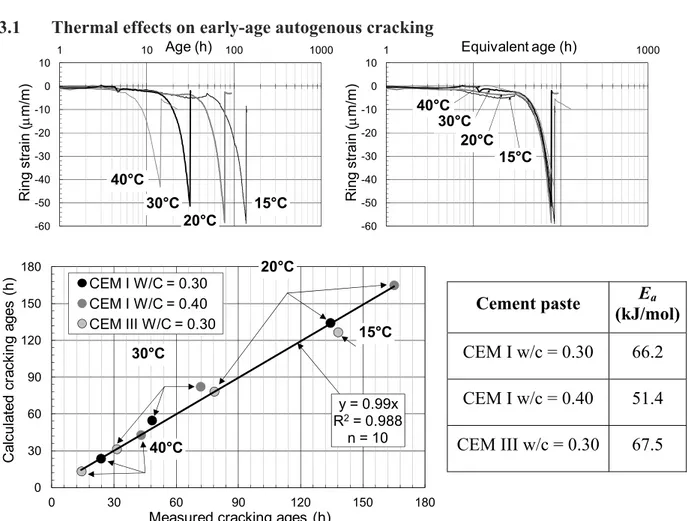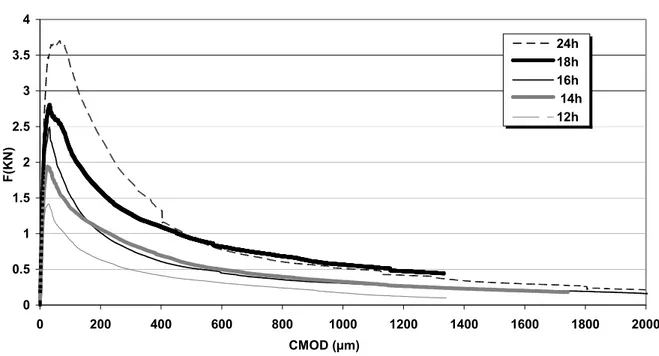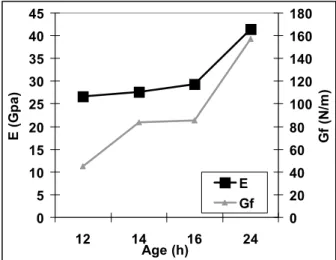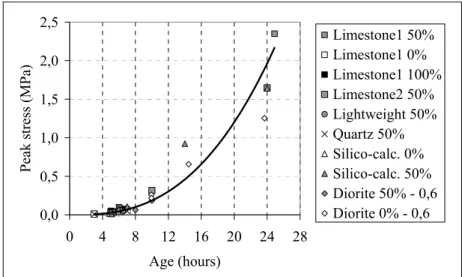HAL Id: hal-01008301
https://hal.archives-ouvertes.fr/hal-01008301
Submitted on 29 Apr 2021HAL is a multi-disciplinary open access archive for the deposit and dissemination of sci-entific research documents, whether they are pub-lished or not. The documents may come from teaching and research institutions in France or
L’archive ouverte pluridisciplinaire HAL, est destinée au dépôt et à la diffusion de documents scientifiques de niveau recherche, publiés ou non, émanant des établissements d’enseignement et de recherche français ou étrangers, des laboratoires
Improving the characterization of early age cracking of
concrete: engineering issues and scientific answers
Frédéric Grondin, Pierre Mounanga, Emmanuel Rozière, Ahmed Loukili,
Mounia Farah, Jean-Pierre Regoin, Arnaud Pertué
To cite this version:
Frédéric Grondin, Pierre Mounanga, Emmanuel Rozière, Ahmed Loukili, Mounia Farah, et al.. Im-proving the characterization of early age cracking of concrete: engineering issues and scientific an-swers. CONCRACK 3 - RILEM-JCI International Workshop on Crack Control of Mass Concrete and Related Issues Concerning Early-Age of Concrete Structures, Mar 2012, Marne-la-Vallée, France. �hal-01008301�
IMPROVING THE CHARACTERIZATION OF EARLY AGE
CRACKING OF CONCRETE: ENGINEERING ISSUES AND
SCIENTIFIC ANSWERS
Frédéric Grondin, Pierre Mounanga, Emmanuel Rozière, Ahmed Loukili, Mounia Farah, Jean-Pierre Regoin, Arnaud Pertué (1)
(1) LUNAM Université, Institut de Recherche en Génie Civil et Mécanique (GeM), UMR-CNRS 6183, France
Abstract
Recent studies on the durability of concrete structures have shown the relevance to take into account the evolution of the strength and the damage of concrete at early ages. Research works conducted at GeM Institute since many years have concerned the characterization of early age cracking. In order to achieve these works specific procedures based on the development of original devices have been proposed. This paper focuses on three of these original procedures. It concerns an application of the ring test method to the study of early-age autogenous shrinkearly-age in temperature-controlled conditions, a direct tensile test device for the determination of the deformation capacity of early-age concrete, and a flexural test procedure for the measurement of the crack energy of concrete at very early ages. Test results are presented and analyzed.
Résumé
Les récentes études sur la durabilité des ouvrages du génie civil ont montré l’importance de tenir compte de l’évolution de la résistance et de l’endommagement du béton au jeune âge. Les travaux menés au GeM depuis plusieurs années ont porté sur la caractérisation de la fissuration des matériaux cimentaires au jeune âge. Pour cela, des procédures spécifiques, nécessitant souvent le développement de dispositifs originaux, ont été élaborées. Cet article présente trois des procédures innovantes mises au point plus récemment. Elles concernent l’extension de l’essai à l’anneau pour un contrôle en température de la fissuration au jeune âge, le développement d’un banc de traction du béton jeune pour la détermination de sa capacité de déformation et la mise en œuvre d’un protocole expérimentale pour la mesure de l’énergie de fissuration de poutre de béton jeune. Des résultats d’essais sont présentés et analysés.
1. INTRODUCTION
The design of concrete structures requires the best understanding of the intrinsic behaviour of the main material and its influence in the structuring elements. For the sake of structure durability, control of concrete cracking is an important aspect to consider in the choice of design. The presence of cracks in concrete actually causes a decrease in the mechanical
strength and an increase in its permeability to external aggressive agents (water, acid, chloride ions, sulphate ions ...).
The idea of linking the behaviour of concrete to the evolution of its early-age properties is not new [1]. Many studies have investigated the early-age concrete cracking. This cracking is caused by the shrinkage of the cement paste during its hydration, restrained by the presence of aggregates [1]. Shrinkage is due to the chemical reduction of the cement hydrates relative to the reactants (clinker and water) and the decrease of the capillary pressure in pores during hydration. It is also due to desiccation. These mechanisms lead to the creation of micro-cracks in the material and change its mechanical properties, which are difficult to assess so far. The damage due to these phenomena is usually not taken into account in models (analytical, empirical or numerical) used to design concrete structures. Generally, these models take into account implicitly the concrete maturity based on mechanical measurements made at the age of 28 days. It is considered that at this age the concrete has achieved almost the maximum of its properties. The GeM explores these questions by developing innovative experimental procedures to measure material properties related to early-age concrete cracking. Based on the experience gained in the study of concrete at very early-age [3], [4], the GeM researchers have developed three procedures to define the properties necessary for the improvement of numerical and analytical models for design.
The first procedure is based on the ring test [5] which was modified in order to have a temperature control. This test is used to define the age and stress of concrete cracking due to the restrained shrinkage by controlling the temperature effects which could cause cracking of the cement paste. The second experimental device is a direct tensile bench for early-age concrete. Concrete is cast in a horizontal mould. The tests are performed from the setting age of the concrete by applying a direct horizontal tensile load. This test is used to assess the tensile strain capacity of concrete at early-age. The third procedure is based on a standard three-point bending test [6]. The tests are performed from the age of 12 hours for concrete and they allow evaluating the flexural strength and the fracture properties used in models (failure energy, crack opening displacement ...). Compressive and tensile properties are also measured at these ages to complete the data and analysis.
First of all, the various devices developed are presented with emphasis on the originality of the experimental procedures. Then, the test results on cement-based materials (mortar and concrete) are analyzed. Finally, a conclusion shows the importance of these studies for the model developers.
2. DEVELOPMENT OF SPECIFIC EXPERIMENTAL METHODS
2.1 Temperature controlled ring test device
Ring tests were performed to measure the autogenous shrinkage of cement pastes in restrained conditions. Indeed, this testing method offers the advantages of simplicity and relative low cost. This technique has been already used in various studies to investigate the cracking risk of cement-based materials due to drying shrinkage [5], [7], [8]. A review of this matter was published by Radlinska et al. [9]. The test device developed here is especially designed for early-age deformations of cementitious matrices since it is equipped with a thermal regulation system allowing the temperature control of the annular sample during the whole testing period [10]. It is therefore possible to both differentiate autogenous strain from
Strain gauges Cement paste ring Metal ring R0 R1 R2 σθ PVC ring R0 = 145 mm R1 = 105 mm R2 = 95 mm σθ : tensile stress Water circulation system B
Crack in cement paste
thermal strain and quantify the effect of temperature on the age of the first crack induced by self-desiccation shrinkage. This latter special feature is especially used in the present paper to investigate the thermoactivation of the early-age autogenous cracking in cement pastes.
The ring test device is presented in Figure 1. It is composed of two aluminium plates and two rings – a PVC ring for the external form and a central metal ring, which acts as the internal form and restraint. The aluminium plates constitute the base and the cover of the assembly. The cement paste specimen cast between the two rings has a cross section of 40 × 40 mm2 and an inner diameter of 210 mm. The internal ring strain induced by the cement paste shrinkage is measured by four strain gauges, axi-symmetrically fixed at the mid-height of the inner surface of the metal rings and connected to a data logging system. The ring test device is thermally regulated with a water circulation system connected to a thermostated water bath (± 0.1°C) via a copper pipe network. Silicon-based thermal grease is applied to the interfaces between the copper tubes and the aluminium plates to improve the heat exchanges.
Figure 1. Temperature-controlled ring test device. A: Principle of the ring test method; B. Photograph of the ring test device; C. Photograph of the complete system
2.2 Flexural testing procedure at early-age
The three-point bending test is commonly used to determine the crack properties of concrete in order to assess its indirect tensile cracking. Tests are made on notched concrete beams which are sufficiently hydrated and have raised their maximum strength [6]. Tests are performed with controlled notch opening displacement which is ensured with a crack mouth opening displacement (CMOD) gauge. Two blades of the CMOD gauge are attached to two metal plates one on either side of the notch at the bottom face of the beam. These metal plates are firmly attached to the specimen with high strength glue, which guarantee the perfect stability of plates and consequently the CMOD gauge. The cracking risk of concrete at early-age can be assessed by applying the three-point bending test with new specifications.
Thermostated water bath Data logging
system
Ring test devices
A
The concrete specimens are poured into moulds of dimensions 100*150*700 mm3. A Teflon plate with a thickness of 3 mm is placed into the mould before pouring the concrete for the notch position. This plate is then removed at the time of the test to reveal the notch. Because the metal plates used to measure the CMOD can not be glued on fresh concrete, two first metal plates are placed into the mould to set in concrete at each side of the notch. Then, one hour before the test, the strip is removed with care to glue two metal plates on the first plates which will be attached to the CMOD gauge, of capacity equal to ±4 mm, each 10mm in length. Also, a square plate is attached in the same condition on the middle of the beam surface in front of the notch for the measurement of the deflection. The specimens are covered with an impermeable plastic sheet and keep in a climatic chamber at a temperature of 20 ±2 °C and a relative humidity of 50% ±5% until the test.
The loading frame consists of Instron make closed loop universal testing of 160 kN capacity. The load was applied with the help of a circular jack to ensure a point load. A rubber pad is placed between the load jack and beam to take care of the surface unevenness and to avoid damage under the load. The beam is simply supported on two circular supports. All the tests are performed with controlled notch opening displacement rate of 0.5μm/sec. Thus load is applied as a function of notch mouth opening. This loading arrangement allows obtaining firstly, a gradual increase in the crack opening and secondly, a steady decrease of load bearing capacity of the beam in the post-peak regime. The mechanical data thus obtained is the evolution of the force with the precision of 1/100 N and the notch mouth opening displacement with the precision of 1/10 of micrometer, acquired after each 1 sec interval. The load is applied in two stages, a preload and then the main load with controlled notch mouth opening displacement. The preload is operated manually. In parallel, cylinder specimens of dimensions φ11*22 cm2
are tested with an ultrasonic method to measure the elastic modulus. In these tests, concrete are mixed with a Portland cement (CEMI) 52.5 N, alluvial sand with a maximum diameter equal to 4 mm, a semi-crushed gravel 4/20. For the workability of concrete we add a small amount of super-plasticizer (Optima 206). The formulation is given in Table 1. The water-to cement (w/c) ratio is 0.42 and the gravel-to-sand (G/S) ratio is 1.25.
Figure 2. The three-point bending device
Table 1. Mix-design of the concrete studied in the three-point bending test
Components Dosage (kg/m3) Gravel 4/20 980 Sand 0/4 785 CEMI 52.2N 400 Super-plasticizer 1.8 Added water 154.1 Effective water 165.9
2.3 Direct tensile testing device
The new procedure enables a reliable assessment of the displacements of concrete through digital image correlation (DIC). Figure 3 shows the tensile testing machine. The load is applied horizontally by an electric displacement-controlled actuator. The load cell is placed between the actuator and the mobile part of the mould. The mould actually comprises two halves with curved transitions to a central part with reduced constant section, 100 mm high, 100 mm long, and 105 mm wide (Figure 4). The inner face is covered with PTFE and protected with thin polyethylene sheets during the test. The two parts of the mould are linked to the frame and the load cell by spherical pin connections.
The concrete specimen was cast in the steel mould just after mixing then vibrated in one layer. An external frame was placed on the plate to avoid displacements of the two halves of the mould due to the vibration and pressure of fresh concrete. The specimen was covered with a polyethylene sheet to avoid drying. The ambient temperature was 20±2 °C. One hour before the test, the polyethylene sheet was removed and the specimen was covered with white then black painting. This resulted in a contrast that enabled the DIC. The loading rate of the actuator was 0.5 µm/s. The displacements of the mould and the concrete specimen were actually monitored by two different devices. Linear variable displacement transducers (LVDT) gave the relative displacements of the two halves of the mould (Figure 4). The displacement of two regions of the central part with reduced section was monitored without any contact by two cameras placed vertically above the frame. The failure actually occurred in this part of the specimen. Then the displacements were deduced from the images through DIC (Ref). Because of displacements between the specimen and the steel mould, the actual loading rate in the central part of the specimen is 0.04 µm/s (150 µm/hour), which is consistent with plastic shrinkage kinetics [11].
The compositions of the concrete mixtures are given in Table 2. A pilot study was done on a normal strength concrete (C0). Another study dealing with the influence of gravel type was done on a series of concrete mixtures Ci with constant water, cement, and sand content.
1
3
3
4
6
2
5
1: Steel mould; 2: Concrete specimen; 3: Spherical pin connection; 4: Electric actuator; 5: Load cell; 6: LVDT2
LVDT 2 LVDT 1
80 mm
Image b Image a
Figure 3. Tensile testing machine Figure 4. Measurement of displacements on the mould and the
Table 2. Mix-design and properties of concrete mixtures (kg/m3) Components C0 Ci Gravel Diorite 10/14 Diorite 6/10 4/20 875 211 - - - 1082 Sand Sea sand 0/4
Crushed limestone 0/4 855 - 367 377 Cement CEM I 52.5 N 303 350
wneta (= wadded + waggregate + wabsorption) 182 175
Sp 0.9 1.8
w/c 0.6 0.5
Slump (mm) 140 160
fc28d (MPa) 49.1 52.5
3. RESULTS AND DISCUSSION
3.1 Thermal effects on early-age autogenous cracking
-60 -50 -40 -30 -20 -10 0 10 1 10 100 1000 Ri ng s tr a in ( μm/m ) Age (h) -60 -50 -40 -30 -20 -10 0 10 1 10 100 1000 Ri ng s tr a in ( μm/m ) Equivalent age (h) Cement paste Ea (kJ/mol) CEM I w/c = 0.30 66.2 CEM I w/c = 0.40 51.4 CEM III w/c = 0.30 67.5 y = 0.99x R2= 0.988 n = 10 0 30 60 90 120 150 180 0 30 60 90 120 150 180 C al c u lat ed c ra c k in g a ges ( h )
Measured cracking ages (h) CEM I W/C = 0.30
CEM I W/C = 0.40 CEM III W/C = 0.30
Figure 5. Ring test results obtained on cement pastes at various temperatures.
A: Strain vs. age; B. Strain vs. equivalent age; C. Measured cracking ages vs. cracking ages calculated using the maturity concept
40°C 30°C 20°C 15°C 40°C 30°C 20°C 15°C 15°C 20°C 30°C 40°C
Figure 5.A presents an example of experimental results obtained with the temperature-controlled ring test device on a cement paste prepared with a cement of type III and a w/c ratio of 0.30. The strain curve evolutions at different temperatures clearly highlighted the thermoactivation of early-age autogenous restrained shrinkage. The age of the first cracking was divided by 1.8, 4.4 and 9.7 at 20, 30 and 40°C, respectively, in comparison with the 15°C-results. A maturity approach was applied to evaluate the relevance of this concept in describing the thermoactivation of early-age autogenous cracking of three cement pastes. For this aim, it was considered that, in “isothermal” conditions, the autogenous cracking occurred at the same maturity level, whatever the curing temperature considered. The strain curves were then expressed as a function of equivalent age calculated as follows:
( )
t( )
T T T R E T t r ref a eq ⎟⎟⋅ ⎠ ⎞ ⎜ ⎜ ⎝ ⎛ ⎟ ⎟ ⎠ ⎞ ⎜ ⎜ ⎝ ⎛ − − =exp 1 1 (1)Where teq is the equivalent age (h) of the cement paste at the curing temperature T (K), Ea
the apparent activation energy for autogenous cracking (J/mol), R the constant of perfect gas (8.314 J/mol.K), Tref the reference temperature (293 K) and tr the real age (h).
Figure 5.B provides the experimental curves as a function of equivalent age for the CEM III cement paste, considering a Ea-value equal to 67.5 kJ/mol. The superposition of the curves
demonstrates that the maturity concept enables to correctly describe the thermoactivation of autogenous cracking age for isothermal curing conditions. As shown in Figure 5.C, the application of this approach to the three cement pastes investigated allows the prediction of their age of autogenous cracking, between 15 and 40°C for the CEM III cement paste (w/c = 0.30) and between 20 and 40°C for the CEM I cement pastes (w/c = 0.30 and 0.40).
3.2 Determination of the failure properties of concrete at early-age
0 0.5 1 1.5 2 2.5 3 3.5 4 0 200 400 600 800 1000 1200 1400 1600 1800 2000 CMOD (µm) F( K N) 24h 18h 16h 14h 12h
Figure 6 shows the differences between the curves Force-CMOD obtained for concrete at different ages from 12h to 24h. The flexural strength and the elastic slope increase with age according to the evolution of the cement hydration. The cohesion between the cement phases becomes stronger which makes the material more rigid. That is confirmed with the measurements of the Young’s modulus (Figure 7). At very early-age, concrete has a ductile behaviour due to the viscosity of the cement paste. Along the hydration, a more fragile behaviour takes place. Thus, one can see that the force decreases after the peak more rapidly with the age.
0 5 10 15 20 25 30 35 40 45 12 14 16 24 Age (h) E (G p a ) 0 20 40 60 80 100 120 140 160 180 Gf ( N /m ) E Gf
Figure 7. Evolution of Young’s modulus and fracture energy with age
The deflection evolution has been also measured at different ages. The fracture energy (Gf) is defined as the surface area under the curve Force-deflection. It represents the dissipated energy along the cracking process firstly stored by concrete under an external load. Concrete deforms with a part of this energy and it stores the other part. The Figure 7 shows the evolution of Gf of concrete with the age. Gf increases more rapidly than the elastic modulus between 12h and 24h. Concrete deforms less with the age because it becomes more rigid and cohesive, so it stores more energy than it spends. Thus, the dissipated energy along the cracking process tends to increase with the age.
3.3 Tensile properties
The stress was deduced from the measured load and the cross section (100x105 mm²). It was actually assumed that the stress distribution was uniform over the central cross section. Figure 8 shows the evolution of the peak stress of specimens of concrete Ci. Different gravels were used at different initial degrees of water saturation (0%, 50% and 100%).
The tensile strength increased very rapidly from the age of 8 hours, which approximately corresponded to the end of setting (according to the Vicat test). Changing the gravel type resulted in significant variations of the strength, which confirmed the relevance of this parameter as far as the tensile behaviour of concrete is concerned. The stress-strain can be deduced from the data recorded before the failure of the specimen (Figure 9). This curve was used to determine the tensile strength ft, the modulus, and the tensile strain capacity εctu.
0,0 0,5 1,0 1,5 2,0 2,5 0 4 8 12 16 20 24 28 Age (hours) Pe ak st re ss (M Pa ) Limestone1 50% Limestone1 0% Limestone1 100% Limestone2 50% Lightweight 50% Quartz 50% Silico-calc. 0% Silico-calc. 50% Diorite 50% - 0,6 Diorite 0% - 0,6
Figure 8. Peak stress of concretes Ci
0,00 0,05 0,10 0,15 0,20 0,25 0,30 0 100 200 300 400 500 600 Strain (µm/m) Stress (MP a)
Tensile strain capacity : εctu= 370 µm/m
ft’ = 0,26 MPa
Modulus: 655 MPa
Figure 9. Strain stress curve of concrete C0 at 10 hours
Only the first part of the curves (before the failure) was used. Complete stress-displacement curves are given [12], [13], but these studies were done at earlier ages (before 7 hours). At 10 hours, the materials began to show a brittle behaviour and it was not possible to monitor the post-peak stage. The values are closely linked to the experimental procedure and the parameters of testing, such as the loading rate. However, this period (10-24 hours) is a critical stage for hardening concrete, because of the kinetics of shrinkage and temperature gradients. Therefore such results can be useful in a comparative approach to optimise concrete mixtures as far as cracking is concerned.
4. CONCLUSIONS AND FUTURE RESEARCH
In order to prevent the cracking of concrete structures at early-ages, designers need information on the evolution of the physico-chemical properties of concrete. The GeM researchers have developed specific experimental methods to determine failure properties of cement-based materials. A new device, for the measurement of the tensile strength, or adapted current devices or procedures have been presented. Experimental tests have been performed to determine the cracking age at different temperatures, the evolution of the mechanical properties (strength, elastic modulus) and the failure properties with the age. These parameters could be used to improve the numerical models to take into account the cracking risk at early-age by considering the shrinkage and the evolution of the material properties which are usually considered constants.
REFERENCES
[1] Wittmann F.H., “Surface tension, shrinkage and strength of hardened cement paste”, Materials and Structures 1 (6) (1968) 547-552
[2] Kovler K., Zhutovsky S., “Overview and future trends of shrinkage research”, Materials and Structures 39 (9) (2006) 827–847
[3] Loukili A., Chopin D., Khelidj A., Le Touzo J.Y., “A new approach to determine autogenous shrinkage of mortar at an early age considering temperature history”, Cement and Concrete
Research 30 (6) (2000) 915–922
[4] Mounanga P., Khelidj A., Loukili A., Baroghel-Bouny V., “Predicting Ca(OH)2 content and chemical shrinkage of hydrating cement pastes using analytical approach”, Cement and Concrete
Research 34 (2) (2004)255–265
[5] Turcry P., Loukili A., Haidar K., Pijaudier-Cabot G., Belarbi A., “Cracking tendency of self-compacting concrete subjected to restrained shrinkage: experimental study and modelling”, J.
Mater. Civil Eng. 18 (1) (2006) 46-54
[6] RILEM 50-FMC Recommendation, “Determination of fracture energy of mortar and concrete by means of three-point bend test on notched beams”, Materials and Structures 18 (1985) 285-290 [7] See, H.T., Attiogbe, E.K. and Miltenberger, M.A., “Shrinkage cracking characteristics of concrete
using ring specimens”, ACI Mater. J. 100 (3) (2003) 239-245
[8] Hossain, A.B. and Weiss, W.J., “The role of specimen geometry and boundary conditions on stress development and cracking in the restrained ring test”, Cement and Concrete Research 36 (1) (2006) 189-199
[9] Radlinska A., Moon J.H., Rajabipour F., Weiss J., “The ring test: a review of recent developments”, International RILEM Conference on Volume Changes of Hardening Concrete: Testing and Mitigation, 20-23 August 2006, Technical University of Denmark, Lyngby, Denmark.
[10] Mounanga P., Bouasker M., Pertué A., Perronnet A., Khelidj A., “Early-age autogenous cracking of cementitious matrices: physico-chemical analysis and micro/macro investigations”, Materials
and Structures 44 (2) (2011) 749-772
[11] Darquennes A., Khokhar M.I.A., Rozière E., Loukili A., Grondin F., Staquet S., “Early age deformations of concrete with high content of mineral additions”, Construction and Building
Materials 25 (2011) 1836-1847
[12] Hannant D.J., Branch J., Mulheron M., “Equipment for tensile testing of fresh concrete”,
Magazine of Concrete Research 51 (4) (1999) 263-267
[13] Dao V.T.N., Dux P.F., Morris P.H., “Tensile Properties of Early-Age Concrete”, ACI Materials
